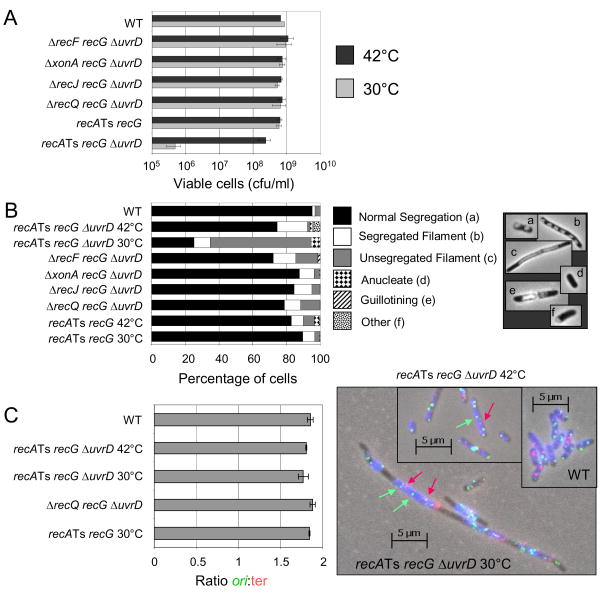Fig. 5.
Chromosome-segregation defects but completed replication during synchronous death of recG ΔuvrD cells. (A) Upon shift of recA(Ts) recG ΔuvrD cells (SMR10740) switched to the permissive temperature (30°C, RecA+ phenotype), from the restrictive temperature (42°C, RecA− phenotype), cells die synchronously and show (B) chromosome-segregation defects as indicated by an increased percentage of filamented cells with unsegregated nucleoids. The chromosome-segregation defect is also rescued by the additional mutation of ΔrecF, ΔxonA, ΔrecJ, or ΔrecQ (Strains SMR10735, SMR10736, SMR10737 and SMR10738 respectively). Control recA(Ts) recG cells (SMR10739) do not show chromosome-segregation defects at the permissive temperature. Mean of 3 experiments. SEM is < 5% of cells/category for all genotypes and temps. (C) Completion of chromosome replication in dying recA(Ts) recG ΔuvrD cells shown by fluorescence in situ hybridization (FISH) to ori (green foci) and terminus-proximal (red foci) chromosomal sequences. Left, the ratios of ori:ter foci in cells are unchanged during synchronous death of recA(Ts) recG ΔuvrD (SMR10740) cells at permissive or restrictive temperatures from those of the non-dying wild-type (rec+, SMR6319) control. The ratio of ori:ter is not different from that of rec+ or recA(Ts) recG (SMR10739) cells, or of ΔrecQ recG ΔuvrD (SMR10738) cells. Right, representative example of FISH data. Images are overlays of phase contrast (blue), red (ter hybridization) and green (ori hybridization) exposures. Red arrows, examples of red ter foci; green arrows, examples of green ori foci. Mean ± SEM of 3 experiments for B and C; ≥ 500 cells scored/genotype/temperature/experiment.

